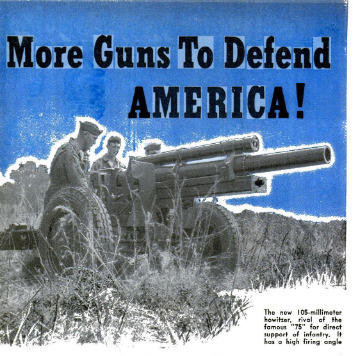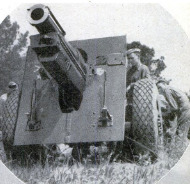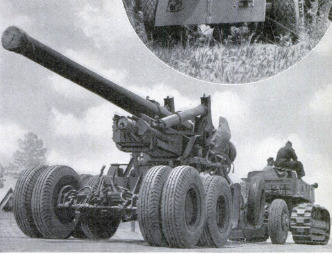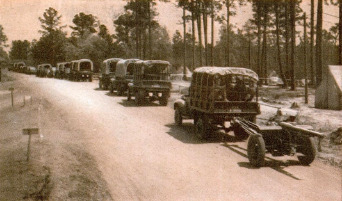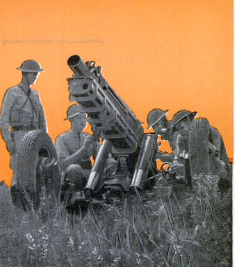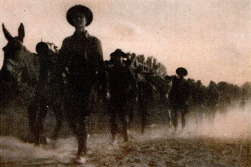-
Title (Dublin Core)
-
More guns to defend America!
-
Article Title and/or Image Caption (Dublin Core)
-
More guns to defend america!
-
extracted text (Extract Text)
-
NO ONE ever heard a fighting soldier
complain that his army had too
much artillery!
To most Americans, and even to some
American Army officers, last spring's Euro-
pean war on land brought a succession of
stunning surprises. The defense-numbing
effectiveness of attacks by massed tanks,
the tremendous hitting power of armored
divisions, breath-taking successes won by
dive bombers, spectacular achievements by
dare-everything parachute troops, insidious
behind-the-lines activities of fifth-column
agents—these developments in the ancient
and sometimes honorable trade of war re-
sulted in a quantity of hard thinking by
American officers. One of the effects has
been a mental rush toward mechanized war
weapons, the mere mention of which only a
year ago would have made the faces of
traditional-minded infantry colonels and
hard-swearing cavalry brigadiers turn
purple with rage.
Perhaps in a few cases this trend toward
mechanization has hardened into a danger-
ous belief that mechanized weapons in them-
selves are a solution of all the complex
problems of model-1940 war. But most of
our officers, no matter to which arm of the
service they may belong, have refused to
become blind worshippers at the shrine of
the militarized monkey wrench. They ap-
preciate fully the value of the new war ma-
chines, but that appreciation hasn't shaken
their conviction that the time-tested combat
team of infantry and artillery remains the
backbone of every army, and that only ar-
tillery can make it possible for attacking in-
fantry to advance and for defending infan-
try to hold its ground.
‘Adequate artillery support in battle usual-
ly means comparatively light infantry
losses. The regular artillery armament of
our big World War divisions of close to
30,000 men consisted of forty-eight 75-
millimeter guns and twenty-four 155-milli-
meter howitzers. It was so inadequate that
‘whenever an infantry division was called on
to make an assault, its artillery had to be
reénforced by the artillery of a division in
reserve. Even then, infantry assaults didn't
always succeed, and infantry losses too
often were high. But when the artillery of
three divisions was used to support the ad-
vance of the infantry of one, success came
quickly and the infantry’s losses were light.
The war strength of our Regular Army's
new triangular or streamline division is
about 12,500 men. Its three small regiments
of infantry are armed with semiautomatic
rifles, machine guns, mortars, and 37-milli-
meter anti-tank guns. Its artillery con-
sists of a regiment of thirty-six 75-milli-
meter guns and a regiment of sixteen 155-
millimeter howitzers.
Outspoken high-ranking officers
say that we need more and bigger
guns in our divisions, and that the
very least we should do is to increase the
number of 155-millimeter howitzers from
sixteen to twenty-four. We're a rich country
—rich enough to buy all the guns we need to
defend ourselves against any enemy, but
not rich enough to pay for the life of a sin-
gle soldier killed unnecessarily because we
fail to see to it that the Army get the guns
it needs to do its national-defense job!
At present our standard light-artillery
weapon is the 75-millimeter—about three-
inch—gun. Contrary to common belief, the
guns our army is using today aren't the
famous French-built 1897-model “75's” with
which we fought in France, but guns built
from French designs in American Army
arsenals late in the World War and shortly
after it. With the original carriage they
had a maximum range of five and a half
miles. With the new American-designed
M-2 high-speed carriage, which permits an
clevation of forty-five degrees and a trav- |
erse of cighty-five degrees, their range
1s over seven and a half miles. |
The Army has a stock of well over 4,000
of these guns. Some are being used by the
Regulars and the National Guard, and the |
rest are in storage. Although they are old
enough to vote, most of them are as good |
as they were the day they were finished.
Modernized with the M-2 carriage at a cost
of about $8,000 each, they are the equals of
any guns of their caliber in the world. |
All our field artillerymen speak aftection-
ately of the “75,” but not all of them are
convinced that it is the best possible weapon
for its primary purpose-the direct support
of infantry with its fire. Many of them
think that the new 105-millimeter howitzer,
designed and after several years of experi.
menting recently perfected by our Ordnance |
Department, is more effective. |
The greatest advantage of the 105 over |
the 75 is the larger bursting charge of its
shell. A battery of four 75's can cover a
front of 120 yards with its fire; a battery of |
four 105's can cover a front of 160 yards. |
It takes an average of 800 fifteen-pound |
75-millimeter shells to blast a lane thirty
yards wide through a barbed-wire entangle-
ment thirty yards deep and 4,000 yards |
away; an average of 525 thirty-three-pound
105-millimeter shells will do the job. |
Another advantage of the 105 is that in
hilly or broken-up country its high-angle
fire can reach targets which the flat-tra-
Jectory 75 gun can't touch. One of the dis-
‘advantages of the 105 is that it weighs a
ton more than the 3,650-pound 75, and so
can't be moved quite so fast. Another is
that its heavier ammunition requires more
motor _transportation—and even a regi-
ment of truck-drawn 75's has to have 110
vehicles to carry its men and equipment
and 120 rounds of shell for its thirty-six
guns!
The potency of the 75 as a tank killer is
a strong point in its favor. The French did
great work with it against the German
heavy tanks which their 37-millimeter anti-
tank guns couldn't do more than dent. Um-
pires at our maneuvers always flag down a
tank, and count it a casualty, if it is unwise
enough to make a target of itself within
1,000 yards or so of a 75 in firing position.
UR other light-artillery weapon is the
75-millimeter howitzer, also poison to
tanks. Hauled swiftly on the road or across
country by half-tracks, it gives artillery
support to our Mechanized Cavalry Brigade.
It also is built in a pack model weighing
only 1,470 pounds which, taken apart, can be
carried by six mules. Throwing a fifteen-
pound shell well over five miles, this pack
howitzer would be a mighty useful weapon
if we ever had to fight in the sort of rough
country which is common in some of our
outlying possessions and in the vicinity of
the Panama Canal.
Our medium artillery
consists of an undisclosed
number of 155-millimeter
howitzers—modernized
four-ton World War guns
which fire a ninety-five-
pound shell seven miles,
and which, towed by
trucks, can do about
140 miles a day on the
road.
NEWEST and longest-
Need of our hay
artillery weapons is the
fifteen-ton 155-millimeter
gun, which has a range of
fifteen miles. Towed by
tractor, it can be moved
100 miles a day. French-
built World War guns of
the same caliber, which
we still have in service,
Rave a range of ten miles.
Our heaviest field gun is
the 240-millimeter howitz-
er—a tractor-hauled thir-
ty-ton monster which
throws a 345-pound shell
nine miles.
There still are some
field-artillery regiments
whose guns are galloped
into action to the stirring
accompaniment of thud-
ding hoofs and rumbling
‘wooden wheels. In all probability, there will
De a few of these picturesque horse-drawn-
gun regiments in our Army for a good
many years to come. There's plenty of
rough country left in the Americas, and in
real rough-country fighting a horse-drawn
gun can move around faster than a truck-
drawn gun. But almost three quarters of
our light artillery has already been motor-
ized, as well as all our medium and heavy
artillery.
The reason for the change is that motor-
ized artillery can move
faster and farther on
the road. With its six-
horse team galloping,
a seventy-five milli-
meter gun can be
moved for a strictly
limited distance at a
top speed of about
twelve miles an hour,
Amotor truck can haul
a 75 mounted on a
pneumatic-tired, high-at the rate of fifty-five or sixty miles an
hour as long as it has a clear road. A long
day's march for horse-drawn light artillery
is thirty miles; truck-drawn light guns
easily can do 175 miles a day. Horse-drawn
artillery can keep up with foot-slogging
doughboys and marching horse cavalry;
truck-drawn guns can keep up with tanks
and motorized infantry.
Field artillery isn't of much use without
the auxiliaries which make it possible for
it to fire accurately. The men at the guns
seldom see what they are shooting at; their
fire is directed by officers in observation
posts connected with the batteries by tele-
phone or radio, and often is corrected by
observers in airplanes or balloons.
One of the most valuable artillery auxil-
fares is the observation battalion. It's the
most highbrow outfit in the Army. Its buck
privates chat about asymptotes and its non-
coms live on intimate terms with the bi-
nomial theorem. Its job is to locate the
enemy's heavy guns by taking cross bear-
ings ‘on their flashes, and by measuring
with scientific accuracy the travel from one
microphone to another of the sound wave
initiated when a gun is fired. The best re-
sults in sound ranging are obtained when
fog or heavy rain blind visual observation.
We have one sound-and-flash observation
battalion in our Army. The Germans have
one with each of their divisions!
We also are short of airplanes especially
designed for the spotting of artillery fire,
and of the successful C-6 motorized obser-
vation balloon which, equipped with a de-
tachable undercarriage with an airplane
engine and propeller, can move from one
place to another at a speed of fifty miles an
hour.
But most vital is the Army's need for
more guns with which to do its national-
defense job. Official figures are not obtain-
able, but it is doubtful that we have more
than one eighth the number we should have.
Deciding on just how many guns, and just
what sort of guns, the Army needs is the
Army's job. Making sure that the Army
gets those guns is the job of every American
citizen!
speed carriage
-
Contributor (Dublin Core)
-
Arthur Grahame (article writer)
-
Language (Dublin Core)
-
eng
-
Date Issued (Dublin Core)
-
1940-10
-
pages (Bibliographic Ontology)
-
58-61,230
-
Rights (Dublin Core)
-
Public domain
-
Archived by (Dublin Core)
-
Sami Akbiyik
-
Marco Bortolami (editor)
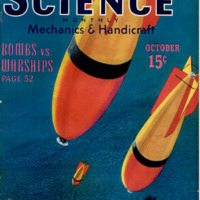 Popular Science Monthly. v. 137. n. 4. 1940
Popular Science Monthly. v. 137. n. 4. 1940

